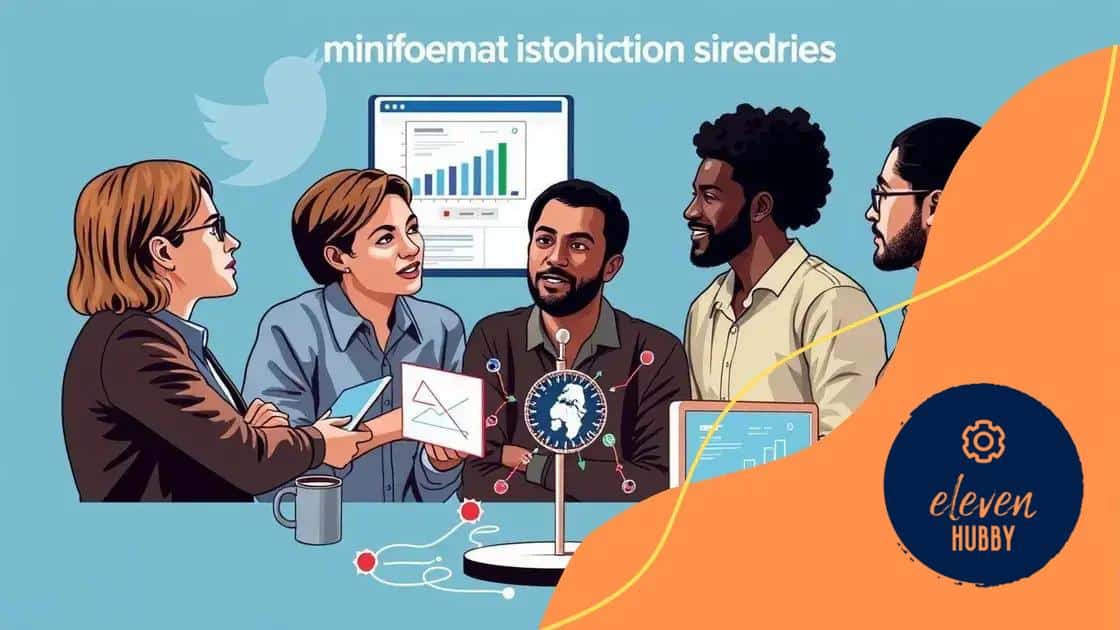Global disinformation control measures: understanding the impact

Global disinformation control measures are strategies designed to identify, mitigate, and prevent the spread of false information using technology, education, and public awareness to create a more informed society.
Global disinformation control measures have become vital in our interconnected world. As misinformation spreads faster than ever, understanding these strategies helps us navigate the complexities of media today.
What are global disinformation control measures?
Global disinformation control measures are crucial tools that help combat misinformation in our society. They aim to identify, mitigate, and prevent the spread of false information across various platforms.
These measures can come from both governmental and non-governmental organizations. It’s important to understand the different approaches used in these strategies to effectively address disinformation.
Types of Global Disinformation Control Measures
Various tactics are employed to manage disinformation. Here are a few key types:
- Fact-checking: This involves verifying the accuracy of information and providing corrections for false claims.
- Public awareness campaigns: These aim to educate the public about how to spot disinformation and promote media literacy.
- Regulations: Governments may implement laws to hold individuals and platforms accountable for spreading false information.
- Technological tools: Advanced algorithms and AI can help detect and flag disinformation before it spreads widely.
Furthermore, cooperation across borders is essential. Different countries often face similar challenges with misinformation. By sharing successful strategies and tools, they can enhance their disinformation control efforts. Collaboration fosters a unified approach that can significantly reduce the impact of global disinformation.
In addition, the role of social media platforms is vital. Many of these platforms implement their own measures to control disinformation. This includes user reporting features, content moderation, and partnerships with fact-checkers. However, challenges remain as the balance between freedom of expression and preventing harm is not always easy to navigate.
Challenges in Implementing Disinformation Measures
Global disinformation control measures are not without obstacles. Some challenges include:
- Resource limitations: Many organizations struggle with funding and manpower to address widespread disinformation.
- Political interests: In some cases, misinformation is used for political gain, making regulation difficult.
- Public trust: Sometimes the public may distrust the sources providing corrections, leading to skepticism towards factual information.
Despite these challenges, it is essential not to lose sight of the ultimate goal: creating a more informed society. By continuing to evolve these measures, we can combat the effects of false information effectively.
History and evolution of disinformation strategies
The history and evolution of disinformation strategies reveal how misinformation has been used throughout the ages. From ancient civilizations to the digital age, the tactics have changed, but the goal remains similar: to manipulate public perception and control narratives.
In the past, disinformation was often spread through written words, such as propaganda leaflets or misleading pamphlets. These tools were crucial during wars, as they aimed to sway public opinion and undermine enemy morale. Over time, as technology advanced, so did the methods of disseminating misinformation.
Early Examples of Disinformation
Historical events often showcase early forms of disinformation strategies.
- World War I: Governments created propaganda posters that distorted facts about the enemy.
- Cold War: Information manipulation was used extensively, with both sides spreading false narratives to discredit each other.
- Election campaigns: Disinformation tactics have been incorporated in many elections to mislead voters.
As we transitioned into the modern era, the rise of the internet dramatically changed how information flows. Today, social media platforms play a significant role in how disinformation spreads. It is easier than ever for false information to go viral, causing confusion and panic among the population.
Modern Disinformation Tactics
With the advent of technology, new strategies emerged. Here are a few modern tactics:
- Deepfakes: These are AI-generated videos that can misrepresent individuals or events.
- Bot networks: Automated accounts that amplify misleading content, making it appear more credible.
- False news sites: Creation of deceptive websites that mimic genuine ones to spread fake stories.
As these strategies evolve, so do the efforts to combat them. Understanding the history of disinformation helps in recognizing patterns and developing better solutions for the future. Staying informed is crucial in this ongoing battle against misinformation.
Key challenges in combating disinformation

Combating disinformation presents multiple challenges that can hinder effective strategies. Understanding these challenges is essential for developing solutions that can minimize the impact of false information.
One major issue is the sheer volume of information that flows through digital platforms every day. With billions of posts on social media, filtering through this content to identify disinformation becomes incredibly difficult.
Challenges in Identifying Disinformation
Identifying the source of false information can be tricky. Disinformation often spreads rapidly and can be disguised as legitimate news. Much of it is created to look credible, making it harder for people to discern fact from fiction. Here are a few specific challenges:
- Confirmation bias: People tend to believe information that aligns with their existing beliefs, making it hard to change minds.
- Anonymity of sources: Many disinformation campaigns operate from anonymous accounts, complicating accountability.
- Emotional triggers: Disinformation often targets emotions, making it more persuasive and harder to combat.
Additionally, regulatory and legal issues complicate the fight against disinformation. Laws that govern freedom of speech can make it challenging to regulate harmful content without infringing on individual rights.
Technological Limitations
Technology also poses challenges in combating false information effectively. Many platforms rely on algorithms designed to maximize engagement, which can inadvertently promote misleading content. Here are a few key technological issues:
- Algorithm bias: Algorithms may favor sensationalist or misleading posts as they often receive more clicks.
- Lack of transparency: Users often don’t understand how content is prioritized, making it difficult to identify biased information.
- Insufficient fact-checking tools: While there are tools available, they are not always reliable or widely used.
These challenges highlight the need for a comprehensive approach that includes education, technology, and stronger regulatory frameworks. By tackling these issues head on, society can improve its ability to combat disinformation effectively.
Effective case studies of disinformation control
Exploring effective case studies of disinformation control provides valuable insights into successful strategies used around the world. Learning from these examples can help develop better tools and methods to combat misinformation.
One notable case is the approach taken by the government of Finland. They launched a comprehensive program to enhance media literacy among citizens. By educating people on how to identify disinformation, they significantly reduced the impact of false claims during critical times.
Finland’s Media Literacy Campaign
This campaign focused on teaching students and adults about critical thinking and information verification. The results showed that those who participated were better equipped to spot fake news. Here are critical aspects of their approach:
- Workshops: Interactive sessions helped participants practice identifying misleading information.
- Collaboration: Schools and government agencies worked together to amplify the message.
- Online resources: Availability of materials that anyone could access for ongoing learning.
Another successful case comes from the United Kingdom, where targeted campaigns were used to combat specific misinformation related to public health issues. During the COVID-19 pandemic, misinformation about vaccines spread rapidly. Health authorities quickly acted to counteract this.
UK’s Public Health Campaign
In response, they created clear messaging that countered myths. This involved coordination with social media companies to prioritize accurate content.
- Engaging influencers: Trusted figures helped spread accurate information to their followers.
- Fact-checking initiatives: Collaborations with fact-checking organizations ensured timely and accurate responses.
- Real-time monitoring: Keeping track of misinformation trends allowed for quick reaction to emerging false narratives.
These case studies showcase the importance of a proactive approach to disinformation control. By learning from the successes of Finland and the UK, other countries can develop their methods to effectively combat misinformation and foster a well-informed public.
Future trends in disinformation management
Understanding future trends in disinformation management is crucial as technology and society evolve. As new challenges arise, so do innovative strategies to combat misinformation. These trends promise a more informed public and better tools for organizations.
One emerging trend is the increased use of artificial intelligence (AI) to detect and combat fake news. AI systems are becoming more sophisticated and capable of analyzing vast amounts of data quickly. This allows for faster identification of false narratives before they spread widely.
The Role of Artificial Intelligence
AI can automate the fact-checking process and enhance the ability to trace the origin of misinformation. Key advantages include:
- Speed: AI can analyze thousands of posts in real-time.
- Pattern recognition: AI algorithms can learn to identify characteristics of false information.
- Scalability: AI solutions can be deployed across various platforms simultaneously.
Another trend is the growing emphasis on media literacy programs. Educating the public about how to identify misinformation is vital. Schools and organizations are increasingly adopting curriculums focused on critical thinking and media analysis. As people become more discerning consumers of information, the spread of disinformation can be curtailed.
Public Awareness Initiatives
A new wave of public awareness campaigns is also emerging. These campaigns aim to inform people about the risks of misinformation. The key components often include:
- Engaging content: Creative visuals and interactive tools can capture attention.
- Collaborations: Partnerships with social media platforms help amplify the message.
- Targeted outreach: Specific demographics are targeted with tailored messaging.
Moreover, regulations surrounding disinformation are likely to become stricter. Governments around the world are recognizing the need for frameworks that hold platforms accountable for the spread of false information. As international cooperation increases, we can expect more consistent policies across borders.
Overall, the future of disinformation management is promising, driven by technology, education, and collaboration. With these advancements, society may become better equipped to mitigate the effects of misinformation in the digital age.
FAQ – Frequently Asked Questions about Global Disinformation Control Measures
What are global disinformation control measures?
These measures are strategies designed to identify, mitigate, and prevent the spread of false information across various platforms.
How can AI help in combating disinformation?
AI can analyze large volumes of data quickly, helping to identify and flag misinformation before it spreads widely.
Why is media literacy important in the fight against disinformation?
Media literacy empowers individuals to critically evaluate the information they encounter, reducing the likelihood of them falling for misinformation.
What role do public awareness campaigns play?
These campaigns educate the public about the risks of misinformation and provide tools to identify fake news, fostering a more informed society.






